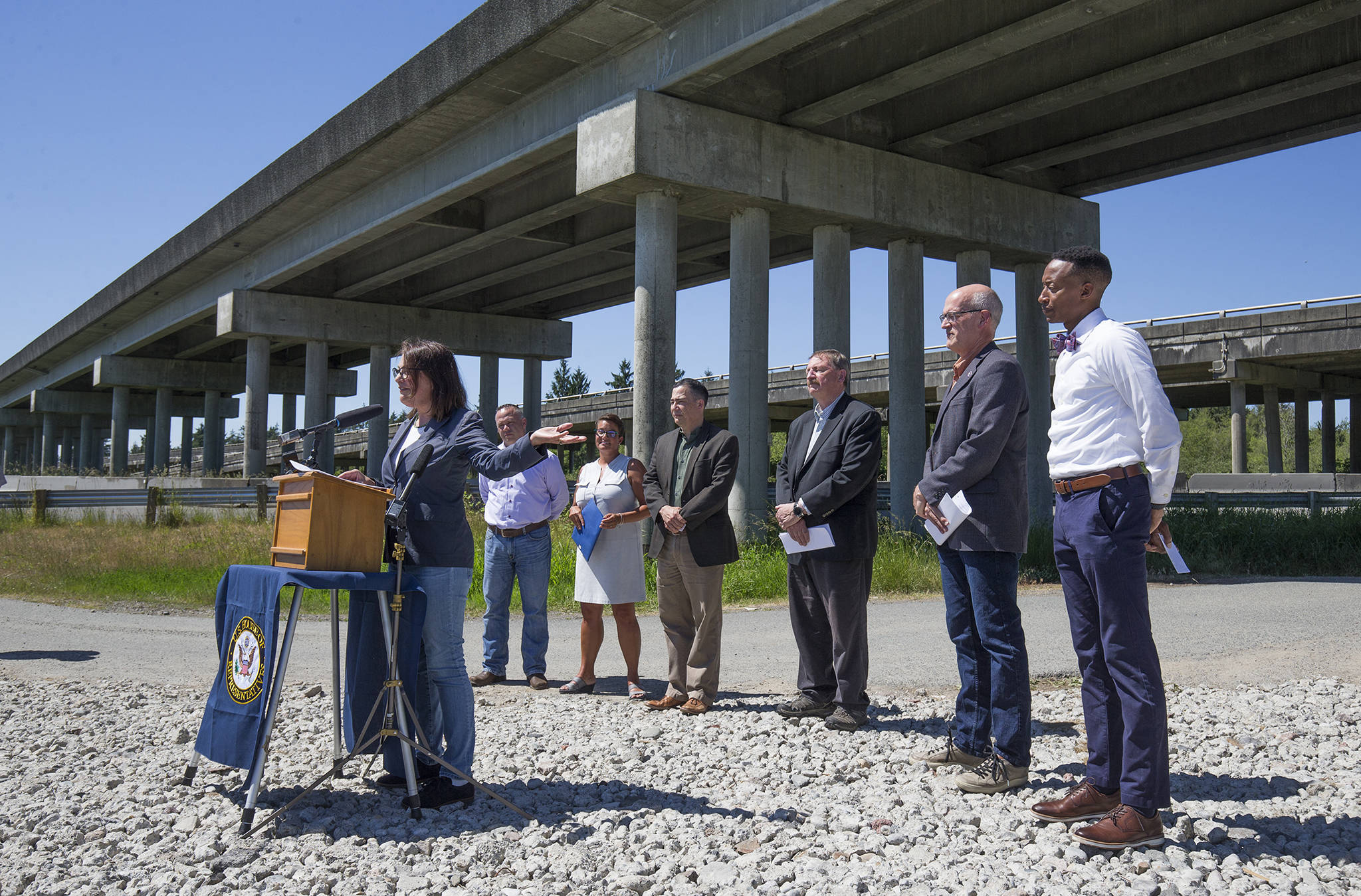By The Herald Editorial Board
The nation has been talking infrastructure for so long — “Infrastructure Week” lasted all four years of the Trump administration, after all — the discussions of need, programs, cost and funding can seem to have had no beginning and no end; an eight-lane Mobius strip with no off-ramps.
Yet there is a deadline, if not an exit: Current funding for federal transportation and other infrastructure programs, renewed about every five years, expires Sept. 30.
At least two recent events have added to the urgency of adopting a significant funding package for the nation’s broad infrastructure needs; or two or more such packages, depending on the path forward: One, we’ve only started out on the road toward economic recovery from the coronavirus pandemic, with demands for job creation and the workers to fill those jobs. Two, the recent Northwest heat wave and its own devastating economic costs has brought a new appreciation for why we need infrastructure that is more resilient against the effects of climate change but also builds on efforts to reduce the emissions from carbon dioxide and other greenhouse gases that cause global warming.
Not that there hasn’t been some movement.
Earlier in June, a bipartisan group of senators announced a $579 billion compromise spending plan that President Biden has endorsed, albeit with a brief wobble. Biden first suggested its passage was contingent on passage of a second, broader, infrastructure package that would pass only through a budget reconciliation process that requires only Democratic votes in the Senate, a condition he later retracted.
And last week, prior to the July 4 holiday break, the House, largely along party lines, passed a $760 billion public works spending plan that allocates funding for specific priorities and projects, including $343 billion for roads, bridges and safety; $109 billion for transit agencies; $95 billion for passenger and freight rail; $117 billion for drinking water; $51 billion for wastewater, and $44 billion in other areas, including $36 billion for adoption of electric vehicles and a network of charging stations.
Of that package, $192.5 million would come to Washington state for specific projects and work in Snohomish County, including $1.68 million toward the up-to-$2 billion replacement of the westbound lanes of the U.S. 2 trestle connecting Lake Stevens and Everett, and $3.9 million to complete design and construction of expansion of 169th Street and its connection from the job magnet Cascade Industrial Center to Smokey Point Boulevard and I-5.
The differences between the Senate and House proposals, however, go beyond the $181 billion gap in spending.
There’s no agreement on how to pay for what’s adopted. Biden and Democrats initially sought a claw-back of Republican-adopted corporate tax cuts, which drew opposition from Republicans and a counter proposal to use unspent funds from pandemic relief packages. Democrats now are seeking to at least bolster spending on the Internal Revenue Service to improve its collection of unpaid taxes.
And, where Senate negotiators and the president have agreed in general terms, the House has outlined policy, then made specific spending proposals, down to the district level.
U.S. Rep. Rick Larsen, D-Wash., following last Thursday’s House vote, described the House action as providing more specifics. “We had to build the bucket first with this legislation,” he said, “and then filled it with programs that show precisely where we want the funding to go to.”
And while only two House Republicans joined all Democrats in voting for what’s called the INVEST in America Act, a number of Republicans who voted against it still included earmarks in the package, specific funding for projects in their districts, including Washington state’s three Republicans, Reps. Cathy McMorris Rodgers, Dan Newhouse and Jaime Herrera Beutler. (Let’s recognize that as an acknowledgement of the need in their own districts, if not the resolve to actually support it.)
Noting the differences between the proposals, Larsen, the 2nd District Democrat and a senior member of the House Transportation and Infrastructure Committee, repeated his message that he would have to wait until something is passed by Congress and on its way to the president to know how it will have passed.
But pass it must, and the more generous the package the better.
Larsen, whenever infrastructure is discussed in news releases and at appearances, such as the June 2 press conference beneath the U.S. 2 trestle with local, state and federal officials, precedes the word with the phrase “bold, FDR-like investment.”
Larsen’s right; it will take that level of investment. And not just sufficient funding of traditional infrastructure. Along with roads, bridges, rail, water and sewer systems, similar investments are just as necessary:
Broadband internet — whose value was proved during the pandemic as it helped connect students with schools, employees with their jobs and patients with medical care — must reach rural and even urban areas where it is lacking.
Transit — including options for electric buses and light-rail systems — must expand to provide a less carbon-intensive alternative for commuters and others.
Electric vehicles — already seen as a more-accessible option for many — must be supported with a network of charging stations. And greater use of EVs by government agencies and companies should be encouraged for their vehicle fleets.
Bike paths and walkable neighborhoods will encourage physical activity that promotes health and reduces carbon emissions.
Support for child care programs will help parents reconnect with training, education, jobs and careers.
College education funding and support for trade and apprenticeship programs are necessary to build back the nation’s workforce with the skills necessary for family-wage jobs that urgently need skilled and knowledgeable workers.
Those investments, as much as any road, provide the infrastructure on which our nation’s economy and society can thrive.
Back in April, a Marist poll, conducted for NPR and the PBS News Hour, found that 56 percent of those polled supported Biden’s American Jobs Plan, and that was at the full $2.25 trillion he originally proposed.
Passage of these and other investments will take compromise and perhaps some fortitude by Democrats to move along with or without Republican support; but any compromise should not result in weak-tea proposals that short-change America’s needs.
Just ahead, there is an exit ramp off this Mobius strip.
Talk to us
> Give us your news tips.
> Send us a letter to the editor.
> More Herald contact information.

























